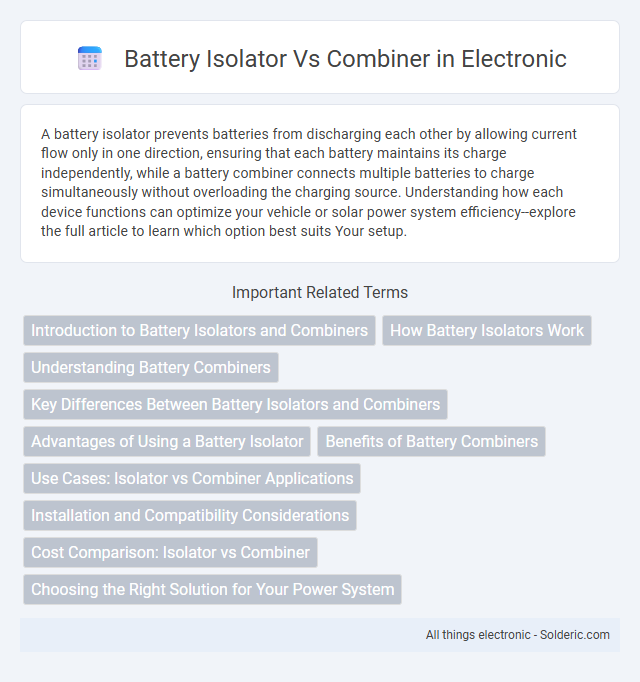A battery isolator prevents batteries from discharging each other by allowing current flow only in one direction, ensuring that each battery maintains its charge independently, while a battery combiner connects multiple batteries to charge simultaneously without overloading the charging source. Understanding how each device functions can optimize your vehicle or solar power system efficiency--explore the full article to learn which option best suits Your setup.
Comparison Table
| Feature | Battery Isolator | Battery Combiner |
|---|---|---|
| Function | Prevents battery discharge between multiple batteries | Combines multiple batteries to charge simultaneously |
| Working Principle | Uses diodes or MOSFETs to isolate batteries electrically | Electronically connects batteries based on voltage thresholds |
| Common Use | In dual battery systems to prevent backflow | In multi-battery setups to optimize charging |
| Voltage Drop | Typically higher due to diode drop | Minimal or no voltage drop |
| Complexity | Simple, fewer components | More complex electronics involved |
| Cost | Generally lower | Generally higher |
| Maintenance | Low maintenance | May require occasional calibration or checks |
Introduction to Battery Isolators and Combiners
Battery isolators and combiners are essential components in multi-battery systems, designed to manage charging and protect battery health. Battery isolators prevent batteries from discharging into each other by directing electrical flow separately, ensuring that the starter battery retains charge for engine ignition. In contrast, battery combiners automatically link batteries during charging phases, allowing multiple batteries to be charged simultaneously while isolating them under load conditions to prevent energy loss.
How Battery Isolators Work
Battery isolators work by allowing multiple batteries to be charged simultaneously from a single alternator while preventing the batteries from discharging into each other. They use diodes or solid-state electronics to direct current flow, ensuring that power flows from the alternator to each battery but does not flow back between batteries. This mechanism protects the starter battery from being drained by auxiliary battery loads, maintaining optimal charge levels and enhancing battery lifespan.
Understanding Battery Combiners
Battery combiners automatically link multiple batteries to charge simultaneously from a single source while preventing discharge of one battery into another. Unlike battery isolators that use diodes to separate battery banks, combiners rely on voltage sensing technology to connect batteries only when the charging voltage is sufficient. This smart operation ensures efficient energy distribution and protects battery health by isolating batteries during low voltage conditions.
Key Differences Between Battery Isolators and Combiners
Battery isolators and combiners serve distinct functions in multi-battery systems; isolators prevent current from flowing back into the starting battery, ensuring your vehicle's main power source remains charged and protected. Combiners automatically link multiple battery banks together during charging, optimizing power distribution and ensuring all batteries receive adequate charge simultaneously. The key difference lies in isolators maintaining battery separation to avoid drain, while combiners focus on unified charging efficiency across batteries.
Advantages of Using a Battery Isolator
Battery isolators prevent the discharge of your main battery by separating multiple batteries, ensuring each battery charges independently without draining others. They enhance battery life by avoiding deep discharges and improve system reliability, especially in RVs, boats, and off-grid solar setups. Using a battery isolator protects sensitive electronics and maximizes power availability across multiple battery banks.
Benefits of Battery Combiners
Battery combiners optimize power management by automatically connecting multiple battery banks during charging, ensuring efficient energy distribution without manual intervention. They enhance battery life by preventing overcharging and enable seamless transition between power sources in dual battery setups. This system maximizes charging efficiency, maintains battery health, and supports reliable power availability for vehicles, marine, and off-grid applications.
Use Cases: Isolator vs Combiner Applications
Battery isolators are best suited for applications requiring separate charging of multiple batteries while preventing current flow between them, commonly used in dual-battery systems in vehicles and RVs to protect the starter battery. Combiners are ideal when you want to charge multiple batteries simultaneously by connecting them in parallel, often used in solar power setups or larger battery banks to optimize charging efficiency. Your choice depends on whether you need to isolate batteries for protection or combine them for synchronized charging in your system.
Installation and Compatibility Considerations
Battery isolators install easily between multiple batteries and a single alternator, ensuring compatibility with lead-acid and lithium-ion battery systems by preventing voltage backflow and battery discharge. Combiners, often used in parallel battery banks, require proper matching of battery voltages and chemistries to avoid imbalance and potential damage, making them suitable for similar battery types and voltages. Choosing between isolators and combiners depends on the specific compatibility requirements and installation complexity for the power system configuration.
Cost Comparison: Isolator vs Combiner
Battery isolators generally cost more upfront than combiners due to their more complex circuitry and ability to prevent battery discharge between multiple sources. Combiners offer a budget-friendly alternative by paralleling batteries during charging but lack the isolation that protects battery health. Your choice depends on balancing initial investment with long-term battery performance and protection needs.
Choosing the Right Solution for Your Power System
Selecting between a battery isolator and a combiner depends on the specific needs of your power system, such as the type of batteries used and load management requirements. Battery isolators prevent batteries from discharging into each other, ensuring isolated charging paths, while combiners allow simultaneous charging of multiple battery banks to maximize efficiency. Understanding factors like system voltage, charging source compatibility, and desired redundancy is crucial for optimizing battery performance and longevity.
Battery isolator vs combiner Infographic

 solderic.com
solderic.com